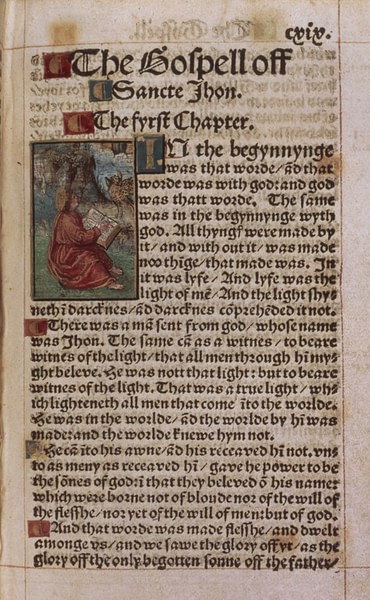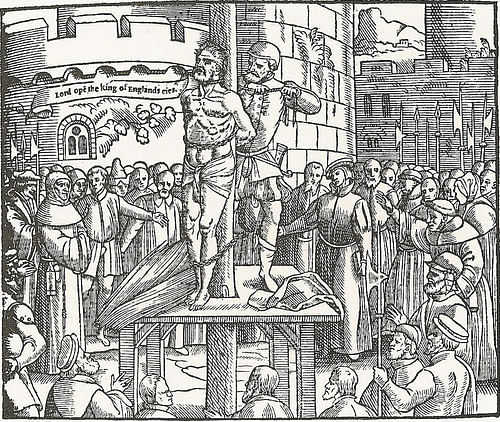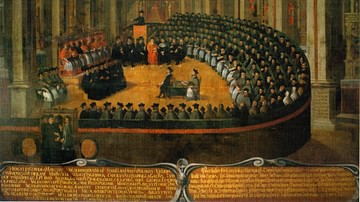
William Tyndale (l.c. 1494-1536) was a talented English linguist, scholar and priest who was the first to translate the Bible into English. Tyndale objected to the Catholic Church’s control of scripture in Latin and the prohibition against an English translation. His work formed the basis of all other English translations of the Bible up through the modern era.
The Latin Vulgate Bible, translated from the original by Saint Jerome (l. 347-420), assisted by Saint Paula (l. 347-404) was considered the only true version by the Church, and translation into the vernacular, in any country, was forbidden. Even before the Reformation began in 1517, however, European scholars had already translated the Bible into their own languages, the German translation by Martin Luther (l. 1483-1546) being only one among many. The proto-reformer John Wycliffe (l. 1330-1384) had translated the Bible from the Vulgate to Middle English in c. 1380 but volumes of this work had been burned after his death.
Tyndale requested permission from ecclesiastical authorities to translate the Bible from the original Hebrew and Greek but was denied. He then left for Germany where he translated and published his work on the New Testament and part of the Old Testament, along with other writings, and had them smuggled into England. Tyndale is recognized as the first to translate the Bible into English, rather than Wycliffe, because he worked from the original languages, not just the Latin translation, as Wycliffe had done.
Tyndale moved about to maintain safety after Henry VIII (r. 1509-1547) called for his arrest and was well-protected by wealthy merchants in Antwerp when he was betrayed by Henry Phillips, a man he thought was his friend, and imprisoned. He was executed by strangulation and his body burned at the stake in October 1536. Three years later, the English version of the Bible completed by his colleague Myles Coverdale (l. 1488-1569) was published in England with the king’s approval. Tyndale and Coverdale are both honored in the present day as the first to translate the Bible into English even though it is acknowledged that Coverdale largely developed Tyndale’s earlier work.
Early Life & Education
Little is known of Tyndale’s early life. He is said to have been born in the village of Stinchcombe, Gloucestershire sometime between 1491-1494 with most scholars favoring the later date. The family was of the upper class, descended from the Tyndales of Northumberland, and his brother, Edward, is recorded as holding a prominent position The family went by the name of Hychyns as well as Tyndale and William Tyndale used both alternately when young. He was educated from an early age, though the details are unknown, and was enrolled at Oxford University in 1506, receiving his Bachelor of Arts degree in 1512 and his master’s degree in 1515.

In 1512 he had also been ordained a priest and served as a subdeacon in religious services. By 1517, he was enrolled at Cambridge University and displayed a talent for learning languages, becoming fluent in French, German, Greek, Hebrew, Italian, Latin, and Spanish. Although associated with the Catholic Church as subdeacon between c. 1512-1521, he seems to have left that position to become a tutor for the children of Sir John Walsh of Gloucestershire c. 1521.
By this time, the religious and social movement that came to be known as the Protestant Reformation was underway in Germany, led by Martin Luther, and in Switzerland through the efforts of Huldrych Zwingli (l. 1484-1531). England, however, remained a Catholic country under Henry VIII who received the honorary title of 'Defender of the Faith' from the Pope for his written work condemning Luther and his teachings. In the same year that Tyndale took the position at the Walsh household, Thomas Wolsey, Cardinal Archbishop of York (l.c. 1473-1530), presided over a public burning of Luther’s works in London at St. Paul’s Cross.
Turn Toward Reform
As with several Catholic clergy who would later become famous Reformers, it may have been this event that first turned Tyndale toward Luther’s teachings. He may have embraced the concept of reform earlier, however, as he is said to have been disgusted by Oxford’s theological program which emphasized learning Church liturgy while ignoring the Bible itself. He would later comment on how too many priests had no knowledge of scripture at all, knowing only the teachings of the Church they had been required to memorize.

He was significantly influenced by Luther, having read Luther’s German Bible, and probably his other works, by 1522 and was outspoken enough in his views that, in that same year, he was called to answer for examination of his beliefs by John Bell, Chancellor of the Diocese of Worcester. The polemicist/historian John Foxe (l. c. 1517-1587) in his Acts and Monuments (better known as Foxe’s Book of Martyrs, 1563) records Tyndale’s now-famous reply to a Catholic clergyman (not Bell) at around this time who tried to steer Tyndale back toward orthodoxy, claiming, “We had better be without God’s laws than the pope’s” to which Tyndale responded, “I defy the pope and all his laws and, if God spares my life, before many years, I will cause the boy that drives the plow to know more of Scripture than thou dost” (Foxe, XII). Perhaps fearing that his views would cause problems for the Walsh family, he left their employ for London in 1523 hoping to find a patron in the bishop Cuthbert Tunstall.
Tunstall had worked with the humanist scholar and theologian Desiderius Erasmus (l. 1466-1536) who had translated the New Testament into Latin from Greek in 1516 and updated Jerome’s Vulgate. Although Erasmus never abandoned Catholicism, he had advocated for reform and Tyndale had good reason to believe that Tunstall, as one of Erasmus’ associates in translation, would be open-minded enough to patronize his own efforts in creating an English Bible. Tunstall turned him down, however, warning him away from “heresy”, and Tyndale then relied on the support of a local merchant, tutoring and lecturing, before leaving for Cologne, Germany in 1524.
Europe & Biblical Translation
He is thought to have spent time in Wittenberg and conferred with Martin Luther as he began his translation of the New Testament which he would complete at Wartburg Castle. He relied on Luther’s German Bible, Erasmus’ Greek New Testament and Latin New Testament, Jerome’s Vulgate, and earlier works in Greek, finishing his English translation in 1525 and publishing it in 1526. Knowing Henry VIII’s condemnation of reformed works, he had his New Testament smuggled into England where it became a best-seller just as, over a hundred years before, Wycliffe’s translation had also.
Tyndale did not simply translate the New Testament, however, but beautified it. The oldest script used in writing biblical books is the Alexandrian text type, followed by the Western and Byzantine text types. Each of these has their own distinctive style with Alexandrian, generally, being more concise and Byzantine more lyrical and flowery. Tyndale seems to have worked from older text type manuscripts in addition to those referenced above and shaped the lines according to his own poetic sensibility.
Tyndale is responsible for some of the best-known biblical passages including “Judge not, lest ye be judged” (Matthew 7:1), “Ask, and it shall be given you; seek, and you shall find; knock, and the door will be opened unto you” (Matthew 7:7; Luke 11:9), and “You are the salt of the earth” (Matthew 5:13). He also translated some key words and concepts in a radically different way than they had been understood, and taught, by the Church.
Among these was the Greek word ekklesia which was understood to mean “church” as interpreted as the Catholic Church. When Jesus Christ says to Saint Peter, “upon this rock I will build my church” (Matthew 16:18) it was understood to mean that Christ was establishing his church – the Catholic Church – through Peter who was regarded as the first pope. Tyndale, however, recognized that a more accurate translation of ekklesia was “congregation”, an interpretation that aligned with the Lutheran concept of a “priesthood of all believers” which echoed Christ’s words, “For where two or three are gathered in my name, there am I in the midst of them” (Matthew 18:20) and so undermined the authority of the Church.
One of the causes of the Bohemian Reformation (c. 1380 to c. 1436) was the Church’s denial of the practice of utraquism (“under both kinds”) meaning both bread and wine should be offered to all believers in good standing during the celebration of the Eucharist. The clergy only offered the congregation bread, keeping the wine for themselves, because it was understood that Christian clergy were above Christian laity because the clergy understood scripture. Tyndale’s translation encouraged the reformed concept that the Church was a false authority as any individual could have access to God through faith and their own reading of the Bible without an intermediary and, when that one gathered with others, they formed a “true” church.
The authorities in England were outraged by the work and it was condemned by Sir Thomas More (l. 1478-1535), Bishop Tunstall, and other clerics. The Tyndale New Testament was not only the first biblical work in English translated from the original languages but the first of its kind produced by the printing press. His New Testament was mass produced and smuggled into England where, at one point, over 16,000 copies were in circulation. As many of these as could be found were confiscated and burned in London at St. Paul’s Cross, just as Luther’s had been, and so were those caught smuggling and distributing them.
Henry VIII & More
Bishop Tunstall and other clerics wanted Tyndale extradited to England to answer charges for heresy and this was supported by Henry VIII, but he also had personal reasons. Henry VIII had wanted an annulment of his marriage to Catherine of Aragon (l. 1485-1536) so he could marry Anne Boleyn (l. c. 1501-1536) in the hope of having a male heir and Tyndale condemned this in his 1530 work The Practice of Prelates. Henry VIII had appealed to the Pope for the annulment citing a passage in Leviticus as justification, but Tyndale pointed out that the passage, Leviticus 20:21, did not support Henry VIII’s claims and what he was attempting was unbiblical. Henry VIII sent word to Charles V, Holy Roman Emperor (r. 1519-1556), pressing for Tyndale’s arrest and extradition but Charles V refused, claiming England had not provided the necessary evidence to support the request.
Tyndale, meanwhile, had been working on revisions to his published work, writing commentaries, and translating the Old Testament. He defended himself in writing against accusations of heresy from Sir Thomas More who was hunting down Tyndale’s associates in England and burning them at the stake along with his works. Where Tyndale was, or for how long, between c. 1526 and c. 1529 is unknown as he seems to have moved frequently to avoid causing problems for benefactors or being arrested. Although Charles V had refused extradition, that did not mean that Tyndale could not be arrested for heresy in the regions of the Holy Roman Empire.
Betrayal & Execution
In 1529 he was living in Antwerp, Belgium where he completed the first five books of the Old Testament and had them shipped to England. He completely revised his New Testament in 1534 at the home of the English merchant Thomas Poyntz who was sympathetic to the reformed cause. At about this time, it is thought, Myles Coverdale – who is known to have been in Antwerp – helped Tyndale with his translations. The Church officials tended to leave the English merchants alone – as well as their guests – because of the immense profit they generated for the city and so Tyndale seems to have been able to live and move about the English quarter freely. In addition to his writing, he ministered to the poor of the area and gave public readings of scripture twice a week.
In 1534, he met a young English student, Henry Phillips, who was enrolled at the University of Leuven and had been a guest at dinners Tyndale also attended. Phillips came from a prominent upper-class family and was educated at Oxford, endearing him to Tyndale as a fellow scholar. Tyndale invited Phillips to dinner several times at the Poyntz home and the two seem to have become close friends, Phillips even staying overnight at times when after-dinner discussions ran late. Poyntz later claimed he never trusted Phillips and, if so, he was right. In early 1535, Phillips invited Tyndale to lunch, drawing him away from the protective neighborhood of the English merchants, and then, after borrowing money from Tyndale, handed him over to the authorities. He was imprisoned in Vilvoorde Castle outside of Brussels and remained there until he was tried and condemned as a heretic in 1536.
As he had established a reputation as a distinguished scholar, he was afforded the courtesy of being strangled before he was burned at the stake. His last words are said to have been a prayer that the king of England would open his eyes, interpreted as the hope that the king would allow for an English translation of scripture available to all. Later writers are in more or less agreement that Henry Phillips was sent by the English clergy, even by Henry VIII himself, to find and betray Tyndale. Phillips would have needed little encouragement to accept payment for the betrayal as he had gambled away his trust fund and was in need of quick cash.
Thomas Cromwell (l. c. 1485-1540) had interceded on Tyndale’s behalf, but Henry VIII refused his request. It is also thought that Anne Boleyn, who was sympathetic to the Reformation, either influenced Cromwell’s intercession or attempted it herself but without success. Phillips was later condemned by Henry VIII for plotting with the Pope against him and became a fugitive, running from English agents shortly after his betrayal of Tyndale and disappearing from history in 1542 in Vienna.

Conclusion
The English Reformation was established in 1534 when Parliament passed the Treason Act, forbidding anyone to speak against the king, and the Act of Supremacy declaring Henry VIII the head of the Church of England and severing ties with the Catholic Church. In the same year Tyndale was executed, Henry VIII and Cromwell begam the dissolution of the monasteries in England and Cromwell issued his Ten Articles which, following Lutheran precepts, rejected four of the seven sacraments of the Church. In 1539, three years after Tyndale’s death, his dying prayer was answered when Henry VIII authorized an English translation of the Bible – the Great Bible – the creation and printing of which was overseen by Coverdale working from Tyndale’s translations. Scholar Diarmaid MacCulloch comments:
Tyndale’s Bible translation, together with the completions of it made by his assistants, formed the basis of all subsequent English Bibles up to the twentieth century: it has had a huge impact on the future of the English-speaking world. Surreptitiously read and discussed during the 1520’s and 1530’s, it worked on the imagination of those who had no access to public preaching because of official repression or lack of provision. It may be significant that there was a perceptible nationwide decline in ordinations in England during the 1520’s: perhaps the traditional Church was losing its grip on those thinking of a clerical career. Tyndale was the first biblical translator of the Reformation to die – arrested and strangled in his Low Countries exile by the Holy Roman Emperor’s officials with the connivance of the Bishop of London and Henry VIII. Yet even before the time of Tyndale’s martyrdom in 1536, perhaps 16,000 copies of his translation had passed into England. (203)
Henry VIII was succeeded by his son Edward VI of England (r. 1547-1553) who continued the Reformation, and he was succeeded by Mary I of England (r. 1553-1558), known as “Bloody Mary” for her execution of Protestants as part of her policy of making England a Catholic country again. Mary I was succeeded by Elizabeth I of England (r. 1558-1603) who reestablished Protestantism firmly before her death and succession by James I of England (r. 1603-1625). James I is well known as the patron responsible for the King James translation of the Bible in 1611 which drew largely from Tyndale’s work. Translations that followed, up to the present day, continue Tyndale’s legacy as a poetic translator, retaining 84% of his work for the New Testament, 76% for the Old Testament, many of the phrases he coined, and fulfilling the vow he once made that, someday, even the lowliest member of society would know scripture as well as those who claimed to be best educated in it.













